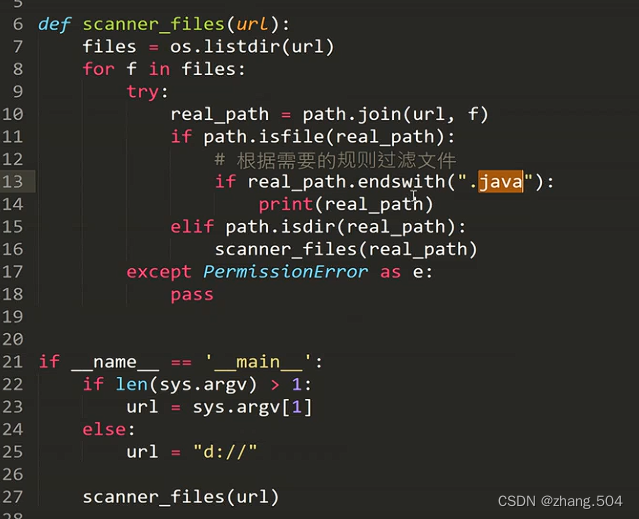1:sys模块
time.struct_time 实现时间转换
>>> import sys
>>> dir(sys)
'getallocatedblocks', 'getdefaultencoding', 'getfilesystemencodeerrors', 'getfilesystemencoding', 'getprofile', 'getrecursionlimit', 'getrefcount', 'getsizeof', 'getswitchinterval', 'gettrace', 'getunicodeinternedsize', 'getwindowsversion', 'hash_info', 'hexversion', 'implementation', 'setprofile', 'setrecursionlimit', 'setswitchinterval', 'settrace', 'stderr', 'stdin', 'stdlib_module_names', 'stdout', 'thread_info', 'unraisablehook', 'version', 'version_info', 'warnoptions', 'winver'
1.1获取递归的限制层数
>>> sys.getrecursionlimit()
1000
>>> #getrecursionlimit 获取递归的限制层数
>>> #setrecursionlimit 解除递归的限制层数

查找以.Java结尾的文件

2:time模块
>>> import time
>>> dir(time)
'altzone', 'asctime', 'ctime', 'daylight', 'get_clock_info', 'gmtime', 'localtime', 'mktime', 'monotonic', 'monotonic_ns', 'perf_counter', 'perf_counter_ns', 'process_time', 'process_time_ns', 'sleep', 'strftime', 'strptime', 'struct_time', 'thread_time', 'thread_time_ns', 'time', 'time_ns', 'timezone', 'tzname'
2.1asctime输出标准时间
>>> #asctime输出标准时间
>>> time.asctime()
'Fri Mar 29 18:44:25 2024'
>>> time.ctime()
'Sat Mar 30 14:00:41 2024'
2.2 gmtime获取当前时间
>>> time.gmtime()
time.struct_time(tm_year=2024, tm_mon=3, tm_mday=30, tm_hour=6, tm_min=2, tm_sec=55, tm_wday=5, tm_yday=90, tm_isdst=0)
2.2.1time.gmtime().tm_year
>>> time.gmtime().tm_year
2024
2.2.2 time.gmtime().tm_mon
>>> time.gmtime().tm_mon
3
>>> now = time.gmtime()
>>> print(f"现在是北京时间{now.tm_year}-{now.tm_mday}{now.tm_hour}")
现在是北京时间2024-306
>>> now = time.localtime()
>>> now
time.struct_time(tm_year=2024, tm_mon=3, tm_mday=30, tm_hour=14, tm_min=10, tm_sec=8, tm_wday=5, tm_yday=90, tm_isdst=0)
2.3#休息时间,python中时间单位是秒,让程序休眠多少秒
>>> time.sleep(4)
>>>
2.4 #time.time()时间戳
>>> time.time()
1711779345.2105186
>>> time.time()
1711779347.1384735
>>> time.time()
1711779348.2027082
2.4.1time.localtime(0)
time.struct_time(tm_year=1970, tm_mon=1, tm_mday=1, tm_hour=8, tm_min=0, tm_sec=0, tm_wday=3, tm_yday=1, tm_isdst=0)
2.4.2 time.gmtime(0)
time.struct_time(tm_year=1970, tm_mon=1, tm_mday=1, tm_hour=0, tm_min=0, tm_sec=0, tm_wday=3, tm_yday=1, tm_isdst=0)
>>> a = time.gmtime(1711779348)
>>> a
time.struct_time(tm_year=2024, tm_mon=3, tm_mday=30, tm_hour=6, tm_min=15, tm_sec=48, tm_wday=5, tm_yday=90, tm_isdst=0)
2.4.3 #将1999年转化为时间戳
>>> time.strptime("1999年3月4日 12:12:12", "%Y年%m月%d日 %H:%M:%S")
time.struct_time(tm_year=1999, tm_mon=3, tm_mday=4, tm_hour=12, tm_min=12, tm_sec=12, tm_wday=3, tm_yday=63, tm_isdst=-1)
>>> t = time.strptime("1999年3月4日 12:12:12", "%Y年%m月%d日 %H:%M:%S")
>>> t
time.struct_time(tm_year=1999, tm_mon=3, tm_mday=4, tm_hour=12, tm_min=12, tm_sec=12, tm_wday=3, tm_yday=63, tm_isdst=-1)
>>> #将1999年转化为时间戳,构建时间戳
>>> t = time.strptime("1999-3-4 12:12:12", "%Y-%m-%d %H:%M:%S")
>>> t
time.struct_time(tm_year=1999, tm_mon=3, tm_mday=4, tm_hour=12, tm_min=12, tm_sec=12, tm_wday=3, tm_yday=63, tm_isdst=-1)
>>>
2.5time.strftime
>>> help(time.strftime)
Help on built-in function strftime in module time:
strftime(...)
strftime(format[, tuple]) -> string
%Y Year with century as a decimal number.
%m Month as a decimal number [01,12].
%d Day of the month as a decimal number [01,31].
%H Hour (24-hour clock) as a decimal number [00,23].
%M Minute as a decimal number [00,59].
%S Second as a decimal number [00,61].
%z Time zone offset from UTC.
%a Locale's abbreviated weekday name.
%A Locale's full weekday name.
%b Locale's abbreviated month name.
%B Locale's full month name.
%c Locale's appropriate date and time representation.
%I Hour (12-hour clock) as a decimal number [01,12].
%p Locale's equivalent of either AM or PM.
>>> time.strftime("%Y年%m月%d日")
'2024年03月30日'
2.6#datatime
>>> dir(datetime)
['MAXYEAR', 'MINYEAR', 'UTC', '__all__', '__builtins__', '__cached__', '__doc__', '__file__', '__loader__', '__name__', '__package__', '__spec__', 'date', 'datetime', 'datetime_CAPI', 'time', 'timedelta', 'timezone', 'tzinfo']
2.6.1构建了一个2024.3.30的一个日期
>>> datetime.date(2024,3,30)
datetime.date(2024, 3, 30)
>>> #构建了一个2024.3.30的一个日期
>>>
>>> datetime.time()
datetime.time(0, 0)
>>> datetime.time(12,12)
datetime.time(12, 12)
>>> datetime.time(12,12,12)
datetime.time(12, 12, 12)
>>> #12点12分121秒
>>>
>>> dir(datetime.date)
'ctime', 'day', 'fromisocalendar', 'fromisoformat', 'fromordinal', 'fromtimestamp', 'isocalendar', 'isoformat', 'isoweekday', 'max', 'min', 'month', 'replace', 'resolution', 'strftime', 'timetuple', 'today', 'toordinal', 'weekday', 'year']
2.6.2 datetime中的datetime模块
>>> from datetime import datetime
>>> datetime
<class 'datetime.datetime'>
>>> dir(datetime)
'astimezone', 'combine', 'ctime', 'date', 'day', 'dst', 'fold', 'fromisocalendar', 'fromisoformat', 'fromordinal', 'fromtimestamp', 'hour', 'isocalendar', 'isoformat', 'isoweekday', 'max', 'microsecond', 'min', 'minute', 'month', 'now', 'replace', 'resolution', 'second', 'strftime', 'strptime', 'time', 'timestamp', 'timetuple', 'timetz', 'today', 'toordinal', 'tzinfo', 'tzname', 'utcfromtimestamp', 'utcnow', 'utcoffset', 'utctimetuple', 'weekday', 'year']
>>> datetime.now()
datetime.datetime(2024, 3, 30, 14, 45, 37, 749918)
>>> s = datetime.now()
>>> s.time()
datetime.time(14, 47, 8, 953058)
>>> s.date()
datetime.date(2024, 3, 30)
>>> s.year
2024
>>> s.month
3
2.7calendar日历
>>> import calendar
>>> print(calendar.month(2024, 3))
March 2024
Mo Tu We Th Fr Sa Su
1 2 3
4 5 6 7 8 9 10
11 12 13 14 15 16 17
18 19 20 21 22 23 24
25 26 27 28 29 30 31>>> # print(calendar.month(2024, 3)) 打印月的日历
>>>
>>>
 消息)
函数的使用)
)
















